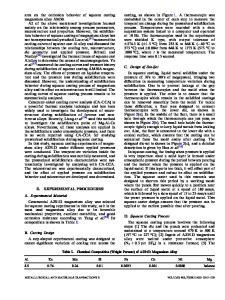Continuous Twin Screw Rheo-Extrusion of an AZ91D Magnesium Alloy
- PDF / 1,666,687 Bytes
- 14 Pages / 593.972 x 792 pts Page_size
- 40 Downloads / 376 Views
UCTION
SINCE the discovery of the semisolid metal (SSM) phenomenon in the early 1970s by the Flemings Group at MIT,[1] SSM processing has been increasingly used for metal forming.[2–4] SSM forming, being conducted at temperatures between the liquidus and solidus of the material, has advantages over solid-state forming such as significantly reduced forming force, unlimited formability, and shortened manufacturing route, and advantages over conventional die casting, including lowered operating temperatures, laminar flow during mold filling, and reduced solidification shrinkage.[2,5] SSM forming offers the potential for significant savings in cost, energy, and resources for metal production. However, the envisaged benefits such as effective process control, microstructure engineering, and property enhancement have yet to be fully realized for the existing SSM processing technologies. Actually, there is an increased complexity in the process control for most of the SSM forming processes, particularly for those via a thixo-route,[6] in which preprocessed alloys of nondendritic microstructures formed by electromagnetic stirring[7,8] or plastic deformation and recrystallization[9–11] are heated to the semisolid region prior to forming. The preprocessed nondendritic alloys are expensive and normally suffer heterogeneous heating before forming. There are several rheo-SSM forming processes, in which semisolid slurry is made directly M. XIA, Senior Research Fellow, Y. HUANG, Lecturer, Z. FAN, Professor, BCAST, and Z. CASSINATH, Postdoctoral Student, are with Brunel University, Uxbridge, Middlesex, UB8 3PH, United Kingdom. Contact «email: [email protected] Manuscript submitted November 22, 2011. Article published online July 19, 2012 METALLURGICAL AND MATERIALS TRANSACTIONS A
from melts, such as gas-induced semisolid rheo-extrusion,[12] cooling tube feeding semisolid rheo-extrusion,[13] single screw rheo-molding,[14] and twin screw rheo-molding.[15] These processes adopt simplified slurry making procedures via a rheo-route and are potentially of enhanced efficiency. However, they are all of batch nature with limited commercial forthcoming. In order to take full advantage of SSM forming technology, it is important to adopt a continuous process via a rheo-route. A continuous process offers enhanced efficiency, productivity, and savings of cost and materials, while a rheo-route represents the simplest route for slurry making. Their combination is thus arguably the best technical approach in terms of commercial competitiveness. Therefore, a twin screw rheo-extrusion (TSRE) process was recently developed at Brunel University as a continuous SSM process for producing wires, rods, and simple profiles of metals and alloys directly from melts. A direct aim of this development was to provide an alternative route for the conventional solid-state extrusion, in which billet feedstock undergoes multiple processing procedures before extrusion such as casting, heat treatment, machining, lubricating, reheating, etc. This TSRE process can be particularly
Data Loading...











